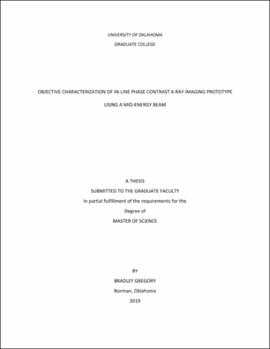| dc.contributor.advisor | Liu, Hong | |
| dc.contributor.author | Gregory, Bradley | |
| dc.date.accessioned | 2019-07-31T13:45:44Z | |
| dc.date.available | 2019-07-31T13:45:44Z | |
| dc.date.issued | 2019-08 | |
| dc.identifier.uri | https://hdl.handle.net/11244/321078 | |
| dc.description.abstract | The purpose of the research presented in this thesis is the characterization of an in-line phase contrast x-ray imaging prototype operating at mid-energy, and to compare the data to that of high energy imaging with the same prototype. The prototype of interest has already been well characterized for high energy in-line phase contrast imaging. High energy imaging was the primary research focus for this prototype because a technique called phase retrieval required high energy phase contrast images to be implemented properly. Phase retrieval recovers a map of the phase shifts detected within a phase contrast image. The phase retrieval algorithm used by partners of this lab group has historically relied on high energy imaging due to its dependence on the phenomenon known as phase-attenuation duality. That algorithm is now under development for mid-energy x-ray imaging as well. Though this research does not involve phase retrieval directly, it is still necessary to characterize the prototype for mid-energy phase contrast imaging, before phase retrieval at mid-energy can be evaluated. The research presented in this thesis involved investigations into three image quality metrics. First, images taken of an edge device were taken to calculate the modulation transfer function. An angle resolution pattern device was then imaged to corroborate the cutoff frequency indicated by the first study. Images were then obtained with no object but with a virtual detector to calculate the noise power spectrum. Finally, the first and second studies’ results were used to calculate the detective quantum efficiency of the prototype system. The study focused on images obtained with a source potential of 60kV, the results from which were compared to those from images obtained with source potentials of 90kV and 120kV. A micro focus x-ray source was used with a CMOS based flat panel detector. The source-to-object and source-to-image distances were set such that a magnification of 2.2 was introduced. Results indicate that the prototype system’s detective quantum efficiency at 60kVp was higher than it was for 90kVp and 120kVp. The mid-energy phase contrast imaging technique has potential for offering high detectability with lower dose to a patient for applications such as breast cancer diagnosis, as compared to current, conventional mammographic procedures.
| en_US |
| dc.language | en_US | en_US |
| dc.rights | Attribution-ShareAlike 4.0 International | * |
| dc.rights.uri | https://creativecommons.org/licenses/by-sa/4.0/ | * |
| dc.subject | Phase Sensitive | en_US |
| dc.subject | X-ray Imaging | en_US |
| dc.subject | In-line Phase Contrast | en_US |
| dc.subject | Image Quality | en_US |
| dc.title | Objective Characterization of In-line Phase Contrast X-ray Imaging Prototype Using a Mid-energy Beam | en_US |
| dc.contributor.committeeMember | Zheng, Bin | |
| dc.contributor.committeeMember | Havlicek, Joseph | |
| dc.date.manuscript | 2019-07 | |
| dc.thesis.degree | Master of Science | en_US |
| ou.group | Gallogly College of Engineering::School of Electrical and Computer Engineering | en_US |
| shareok.orcid | 0000-0003-2328-9452 | en_US |

